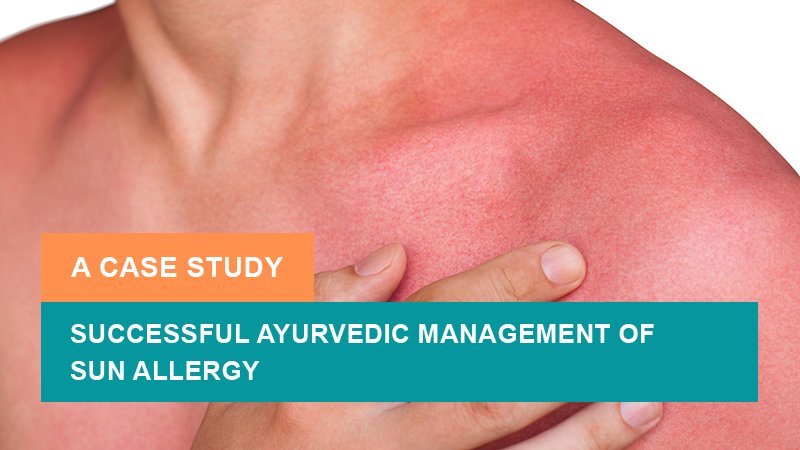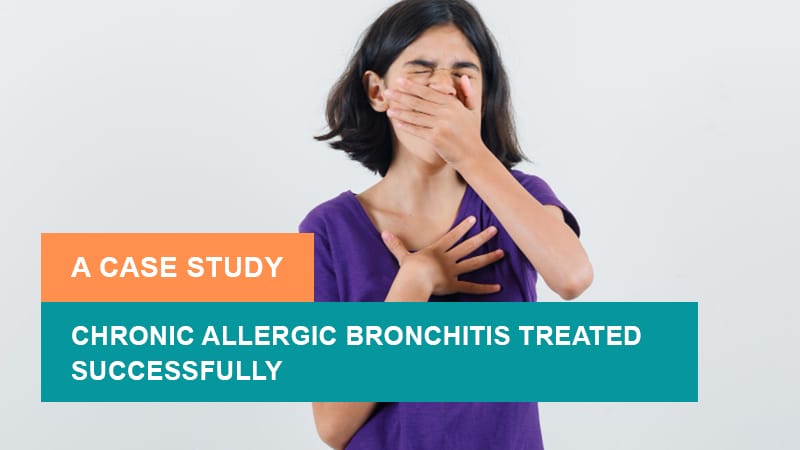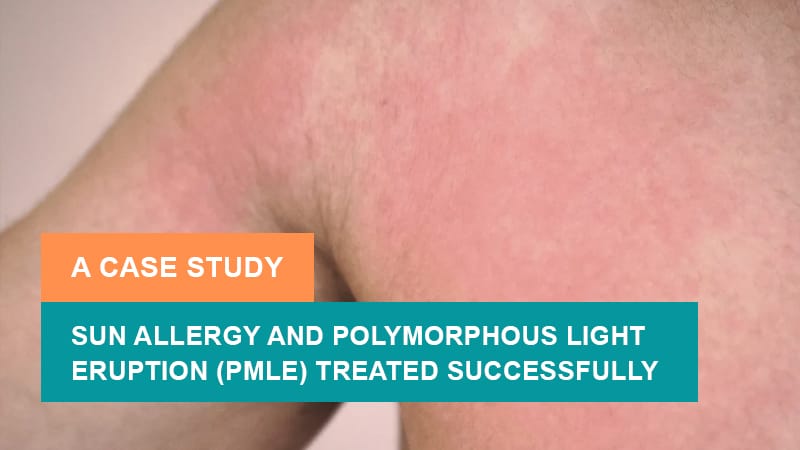Rare allergies like Sun allergy can be successfully treated with Ayurvedic treatment. Dr. Gupta, a well-known Ayurvedic Allergy Specialist, and founder of the Institute of Applied Food Allergy® has successfully treated sun allergy patients around the world. The natural treatment of Sun Allergy is one among IAFA’s successful measures. This blog presents a case study of sun allergy successfully treated in IAFA®.
Read: Sun Allergy – Causes, Symptoms, and Treatment
Abstract
Herbs have been used in cosmetics since centuries. The potential of herbs to adorn and improve the skin appearance is well-known in Ayurveda. In some individuals, sun rays cause sunburns, wrinkles, inflammations, premature aging, etc. So, there is a need for permanent protection from UV radiation and preventions from their side effects as well. Herbs and herbal remedies for sun allergy have a high potential to protect against sun allergy due to their antioxidant activity. According to Ayurveda, this condition is caused due to the vitiation of Pitta dosha. This paper presents a case study of an Indian woman residing in Canada with a history of hypersensitivity reaction during exposure to sun from the last many years. She approached the online OPD of IAFA and was treated successfully with Ayurvedic treatment. Significant changes were observed in the patient’s condition after regular treatment. The patient is completely satisfied with Ayurvedic treatment. This review covers all the aspects of the potential of herbs as radioprotective agents and its future prospects for researchers and offers scope for the natural treatment of sun allergy.
Keywords: Sun Allergy, Antioxidants, Ayurveda, Natural Treatment, Alternative treatment.
Introduction
Sun allergy, also known as solar urticaria is the allergic reaction of skin exposed to sunlight. The area exposed to sunlight may develop rashes with itching. It is a rare allergy that can be hereditary and can develop at any age. Sunlight activates the body to produce antibodies that stimulate the secretion of histamines and other chemicals. It is more commonly seen in people who have a family history of sunlight allergy, having other allergic skin diseases, who regularly use chemical based cosmetic products that cause irritation, etc.
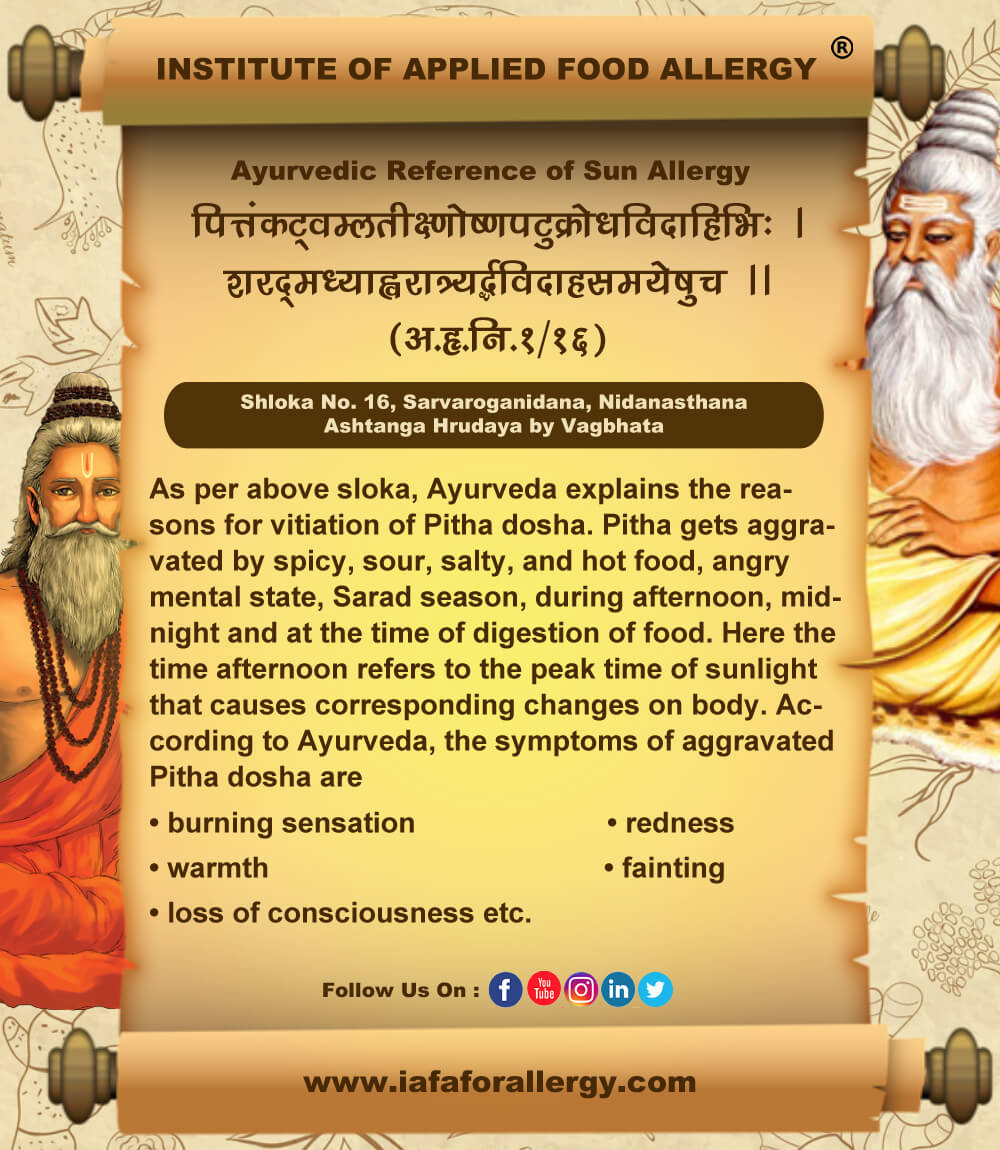
As per above sloka, Ayurveda explains the reasons for vitiation of Pitta dosha. Pitha gets aggravated by spicy, sour, salty, and hot food, angry mental state, Sarad season, during afternoon, midnight and at the time of digestion of food. Here the afternoon refers to the peak time of sunlight that causes corresponding changes in the body. According to Ayurveda, the symptoms of aggravated Pitta dosha are:-
- Burning sensation,
- Redness,
- Warmth,
- Fainting,
- Loss of consciousness etc.
According to Ayurveda, aggravation of Pitta dosha causes sun allergy. Ayurveda explains that aggravation of Pitta dosha occurs due to intake of spicy, sour, salty and hot food and at mental level, anger, jealousy etc. also lead to vitiation of Pitta dosha. Ayurveda also says that during the afternoon, there are chances of aggravation of Pitta dosha due to intensity of sunlight.
Case Report
- Patient Name: Jeewan Jyoti
- Address: Canada
- Age/Sex: 35/F
- UID: 6467
- Date of Consultation: 09/09/2021
- Diagnosis: Sun Allergy
A 35-year-old Indian woman residing in Canada presented in the Outpatient Department (OPD) of the Institute of Applied Food Allergy® (IAFA) through online video consultation, India with complaints of hypersensitivity reaction during exposure to the sun from the last 8-9 years.
Dr. Gupta, an eminent allergist in the field of Ayurveda had examined the patient and made a diagnosis of sun allergy. Considering the history and examination, Ayurvedic treatment for balancing Pitta dosha was prescribed.
She had the Following Symptoms When She Consulted IAFA:
- Redness
- Rashes with hives
The symptoms are self-limiting within 3-4 days if she does not go outside in exposure to direct sunlight.
Treatment Plan
Medications for External Application:
- IAFA Skin Fresh Bar – Application of IAFA Skin Fresh Bar on the whole- body during bathing.
- IAFA AF – 7 Cream – Application of IAFA AF-7 Cream twice or thrice a day over the affected area.
Medications for Internal Use:
- IAFA Skin Detox Tablet – 2 tablets twice a day after taking meals.
- Pitpapra Capsules – 1 capsule twice a day early in the morning empty stomach and early evening with water.
- IAFA AF-7 Tea – ½ teaspoon (2.5 g approx.) for 1 cup of tea twice a day with honey or jaggery.
Product Description
1. IAFA Skin Fresh Bar:
IAFA Skin Fresh Bar is a perfect Ayurvedic solution for intense moisturizing effect with ultimate skin care. It is a unique preparation that is carefully crafted with herbal ingredients such as: Sveta Kutaj, Neelini and Kumari. These herbs have anti-allergic, anti-inflammatory and antioxidant properties. This bar is further fortified with 7 essential oils such as – Avocado oil, Almond oil, Pongamia oil, Wheat germ oil, Manjistadi oil, Castor oil and Coconut oil. The soap also contains herbs like – Lodhar, Nimba, Chakramarda etc. which are antioxidants and antimicrobial in nature.
- Sveta Kutaj (Holarrhena antidysenterica): Kutaj is a cooling herb, possessing pungent vipaka (biotransformation) effect. It balances Pitta and Kapha doshas.
- Neelini (Indigofera tinctoria): The leaf extract of neelini is very beneficial for redness, itching, and flakiness of the skin due to its anti-inflammatory property.
- Kumari (Aloe barbadensis): Kumari, known as Aloe vera has been scientifically proven for all forms of burns. It has a prophylactic effect if used before, during or after the skin damaging events. It is a uniquely effective moisturizer and a healing agent for the skin.
- Lodhar (Symplocos racemosa): Being an astringent and cooling herb, lodhar has been widely used in the treatment of skin disorders since ancient times.
- Nimba (Azadirachta indica): Nimba, commonly known as neem leaves, is a natural antiseptic. It is helpful in Pachana (metabolism) of Ama visha (toxins) and corrects vitiated rasa dhatu in the body.
- Chakramarda (Cassia tora): Chakramarda is widely used as a medicinal herb for the treatment of skin disorders. It is commonly known as the Ringworm plant. It has anti-itching, anti-inflammatory, anti-microbial and hepatoprotective activities.
2. IAFA AF-7 Cream:
IAFA AF-7 Cream is a powerful mixture of antioxidant, anti-inflammatory, anti-allergic herbs for sun allergy such as – Haridra (Curcuma longa), Daru Haridra (Berberis aristata), Nimba (Azadirachta indica), Sirisa (Albizia lebbeck), Tulsi (Ocimum sanctum), Sigru (Moringa oleifera), Seena (Cassia angustifolia), Chakarmard (Cassia tora) and Coconut Oil (Cocos nucifera).
- Haridra (Curcuma longa): Curcumin is regarded as the most active constituent of Curcuma species. Curcumin exhibits antioxidant, anti-inflammatory, anti-histaminic, visha ghana (detoxifier) properties.
- Daru Haridra (Berberis aristata): Daruharidra, also known as Tree turmeric, is beneficial in skin problems due to its anti-inflammatory effect. It has Ropan (healing) properties as well. It also protects the skin from the damage caused by free radicals as it has antioxidant, anti-inflammatory and hepatoprotective activities.
- Nimba (Azadirachta indica): Nimba has tikta rasa (tikta rasa is said to be kushta ghana and raktashodhak properties, thus acting on skin disorders), shamanam (pacificatory), varnya (blood purificatory), Pitta shamaka (pitta pacifying) properties that are useful in sun allergy.
- Sirisa (Albizia lebbeck): Sirisa is considered as Varnya (improves skin complexion) herb in Ayurveda. It detoxifies the skin, relieves itching, inflammation and balances all the three doshas.
- Tulsi (Ocimum sanctum): Tulsi is a well-known herb for its numerous health and beauty benefits. Owing to its properties, tulsi can be used in treating a variety of skin allergic disorders. It is found effective in generalized itching and skin rashes and hives.
- Sigru (Moringa oleifera): Sigru, commonly known as drumstick, is one of the most commonly used herbs for medicinal purposes. It is useful in a variety of skin conditions including allergies, urticaria, acne, pruritis etc.
- Senna (Cassia angustifolia): Senna leaves are known to possess koshta shuddhi (cleaning of bowel) action. According to Acharya Charak, prior to administration of Rasayana (rejuvenative) herbs, it is necessary to perform shodhana (cleansing) action with purgative and senna leaves have the best purgative action.
- Chakramarda (Cassia tora): The seeds of Chakramarda plant act as blood purifier and useful in the treatment of a number of skin disorders such as itching, wounds. Chakra refers to wheel or ringworm; it is also used to treat ringworm infection.
- Coconut Oil (Cocos nucifera): Coconut oil is said to be tvachya by Charak. It has sukshma guna so it penetrates into the microchannels of skin and is useful in kandu (itching) associated with sun allergy.
3. IAFA Skin Detox Tablet:
The key ingredients of IAFA Skin Detox Tablet are: Vasa (Adhatoda vasica), Bakayan (Melia azedarach), Vyaghri (Solanum surattense), Patola (Trichosanthus diocia), Khadira (Acacia catechu), Krimijit (Embelia ribes), Amritha (Tinospora cordifolia), Karanja (Pongamia glabra), Trifla (Compound drug) and Mahamanjistadi Kwath (kwath).
- Vasa (Adhatoda vasica): The antioxidant and anti-bacterial properties of Vasaka are helpful in treating itching, redness, inflammation etc. The phytoconstituents present in vasaka help in treating skin allergic conditions.
- Bakayan (Melia azedarach): The leaves of bakayan are useful in treating skin disorders due to its blood detoxifying, anti-inflammatory properties which are helpful in protecting various skin disorders.
- Vyaghri (Solanum surattense): Vyaghri is one among Dashamoola – a group of 10 roots. It possesses shothahara (anti-inflammatory) properties. It is a bitter and pungent tasting group of herbs. It improves Agni (digestive fire) due to its deepan (appetizer) and pachan (digestive) properties.
- Patola (Trichosanthus diocia): Patola, commonly known as Parwal, widely used as a vegetable in India. Patola has anti-inflammatory, antihistamine and anti-allergic properties due to which it is widely used in the treatment of skin disorders.
- Khadira (Acacia catechu): Khadira is a choice of herb for all disorders pertaining to skin. Due to its property of eliminating itching, inflammation, infection etc., it is useful in treating sun allergy by eliminating the root cause of the disease.
- Krimijit (Embelia ribes): Krimijit, as the name suggests, is one of the powerful anti-parasitic herbs of Ayurveda. It helps in infective skin disorders and eases the movement of bowels in the intestinal tract and useful in weak digestion.
- Amritha (Tinospora cordifolia): Amritha, known as Guduchi is a kushtaghana and rasayana herb that has anti-allergic, immunomodulatory, antioxidant and hepatoprotective properties.
- Karanja (Pongamia glabra): Karanja plant has proven immunomodulation, anti-allergic and anti-viral actions. It also protects the skin from UV rays.
- Trifla (Compound drug): Trifla is a well-known compound drug used in Ayurveda for its Rasayana (rejuvenation) effect. It balances Pitta dosha. It is used for Shodhganga (purification). Trifla has been mentioned in kushtaghana mahakashaya by Acharaya Charak.
- Mahamanjisthadi Kwath: Mahamanjisthadi Kwath is a classical Ayurvedic medicine containing Manjistha (Rubia cordifolia) as a main ingredient. It helps in improving skin problems by acting as a blood purifier, preventing infections and bringing glow to the skin.
4. Pitpapra Capsules:
IAFA Pitpapra Capsules contain the purified extract of Pitpapra (Fumaria indica) herb. Pitpapra is an effective Ayurvedic herb for balancing high Pitta conditions. It is light to digest and has cooling potency.
5. IAFA AF-7 Tea:
IAFA AF – 7 Tea is a proprietary Ayurvedic preparation consisting of 7 immune system rejuvenating herbs useful in skin allergies of various etiologies. It is a mixture of following ingredients: Katurohini (Picrorhiza kurroa), Pada (Cissampelos pareira), Daruharidra (Berberis aristata), Manjistha (Rubia cordifolia), Kutaja (Holarrhena antidysenterica), Khadira (Acacia catechu) and Chirayata (Swertia chirata).
- Katurohini (Picrorhiza kurroa): Katurohini, commonly known as Kutki, is a cleansing and cooling herb due to its bitter taste. It is a Pitta pacifier in nature. It possesses choleretic effects.
- Pada (Cissampelos pareira): This herb is commonly known as Patha. It detoxifies and relieves skin disorders.
- Daruharidra (Berberis aristata): Daruharidra is used in Ayurveda to treat skin disorders with itching due to its anti-inflammatory property. The qualities and usage of daruharidra are quite similar to the benefits of turmeric.
- Manjistha (Rubia cordifolia): Manjistha is widely used in the treatment of skin disorders. All Ayurvedic formulations for skin disorders contain manjistha as an ingredient due to its antiseptic, anti-inflammatory and galacto-purifier activity. It is used internally to gain luster and glow of the skin.
- Kutaja (Holarrhena antidysenterica): The bark of Kutaja tree is bitter, astringent, dry in nature, has cold potency, undergoes pungent taste conversion after digestion and balances Pitta and Kapha doshas. It treats the burning sensation and aggravation of Pitta dosha.
- Khadira (Acacia catechu): Khadira acts as Kaphapitta hara, raktashodhak, antioxidant, anti-inflammatory and hepatoprotective properties, therefore useful in the treatment of sun allergy.
- Chirayata (Swertia chirata): Chirayata helps in purifying blood naturally to get healthy and glowing skin without any side effects. It is packed with powerful antioxidant compounds as well.
Dietary Guidance
- Intake of green gram, old rice, whole corn, millets, oats and grains in the diet was recommended.
- Use of aloe vera gel on the exposed body parts was also recommended.
- Intake of more fresh fruits and vegetables in the diet was also recommended to the patient.
- Intake of spicy food especially pickle, full cream milk and dairy products, whey, cream cheese and soft cheeses, butter, fatty, fried or greasy food, spicy and sour food should be avoided.
- Yoga postures such as Trikonasana, Uthanasana, Pawanmuktasana, Chakrasana and pranayama were recommended to the patient.
Outcome Measures and Follow-Up
After 3 months, patients got relief from sun allergy after taking treatment from IAFA. The patient was totally satisfied with the Ayurvedic treatment and she is glad that she can sit in the sun as long as she wants without having burns on the skin.
Patient’s Review
“I have been suffering from Sun Allergy for 15 years. Exposing my skin to the sun for a small duration would give me hives and rashes that would last for days. I stumbled upon IAFA on the internet, desperate to find a solution and I’m glad that I did. It’s been 3 months since I started the treatment, and I can sit in the sun as long as I want without burning my skin. I highly recommend IAFA for any allergy issues.” – https://goo.gl/maps/HvdVkx2MCdLNNqov8
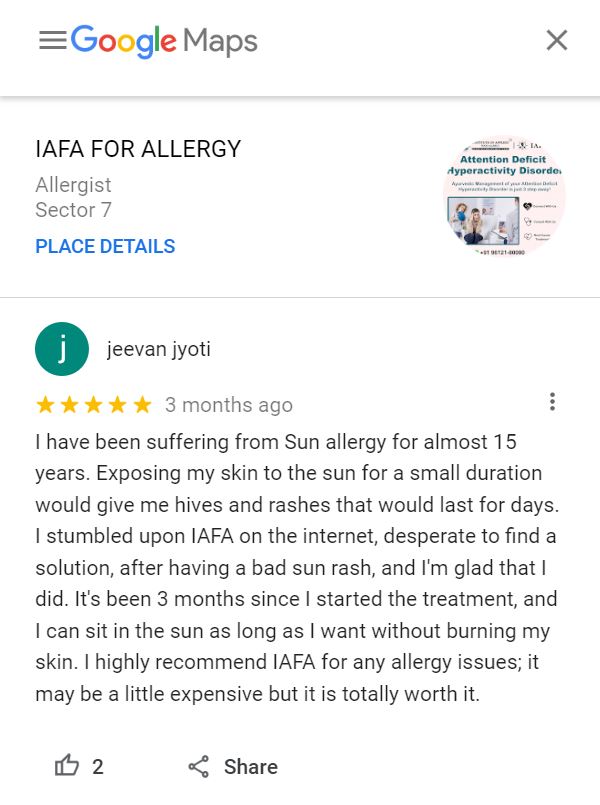
Conclusion
The Ayurvedic treatment provides relief from sun allergy from the very high temperature of the sun causing allergic reactions without compromising SPF numbers. There are herbs available that protect the skin from the harmful rays of the sun. This case study shows that sun allergy can be managed successfully with Ayurvedic intervention under expert guidance. The patient is content with the sun allergy Ayurvedic treatment and thankful to IAFA.


